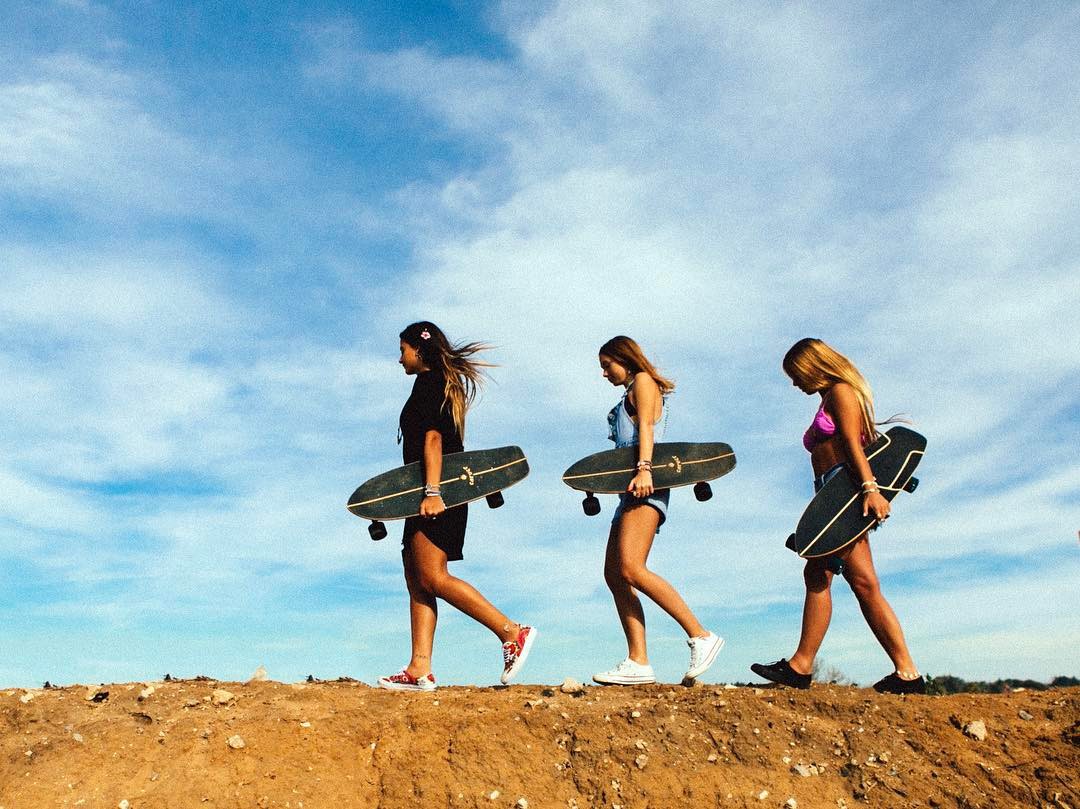The first “skateboard” prototypes were built in California in the 1950s by tube-hungry surfers in search of the perfect wave and a solution that would enable them to overcome the long periods of summer flat.
In 1961, two Californian surfers Mickey Muñoz and Phil Edwards created the first version of the modern skateboard (the wheels are still made of clay) and made this sweet dream possible: the infinite wave is not far away.

In the meantime, the skateboard industry has organised itself and has become a world apart with its millions of people riding daily in the streets, its stars (Tony Hawk, Nyjah Huston, P-Rod…) and its events (X-Games, Dew Tour and Olympic Games for 2020).
Nevertheless, Skateboarding remains a discipline that is quite complementary to Surfing and allows many surfers to work on essential technical and physical points. For example, many surfers work on their curves or their Air in the Bowls: John John Florence, Sally Fitzgibbons, Mick Fanning, Michel Bourez, Jordy Smith…
Over the last few decades, many innovations have been introduced to diversify practices: longboard (for downhill riding), cruiser (city rides) and more recently SurfSkate.



The great particularity of SurfSkates compared to other boards is to propose an articulated front trick which allows to find the sensations of surfing, in all fluidity (for the best SurfSkates).
In a few words, no more need to put your foot on the ground to move forward, you just “pump” by making movements from left to right, which remains accessible even to those who have never skated before. Remember also that SurfSkate is mainly practiced on smooth ground: flat or in a Skatepark (with protective equipment). Big and long descents are generally not suitable for SurfSkate even if it is often possible to adjust the hardness of the springs.



In short, with SurfSkate, skateboarding has never been so close to surfing and surfers who have tried it often can’t do without it. Indeed, the benefits of SurfSkate for a surfer are numerous :
From a technical point of view :
- Improvement of balance and proprioception (especially the role of the back foot in the supports);
- Improvement of the “look” and the positioning of the shoulders in order to anticipate manoeuvres;
- High potential for improvement for basic manoeuvres (frontside & backside): bottom-turn, cutback and roller as well as for aerial manoeuvres : Front/Backside Airs, Grab Rail and Superman Airs ;
- Quick learning of “pumping” to gain speed, like in surfing ;
- Most of the details you wish to work on for Surfing (position of the arms, pelvis, supports, sequences) can be repeated a large number of times unlike Surfing sessions: more rare and made up of 80% of oar.
From a Physical and Mental point of view :
- Speed and risk-taking (big waves) should scare you less after a few falls on concrete =) ;
- Strengthen your thighs ! But also of the back (sheathing), abdominals and calves;
- More flexibility!
- What a kick to be able to continue “surfing” when the conditions are not right: flat, storms, (too) cold water, city life !
- Contributes to the surfer’s mental preparation: positive attitude (no waves = SurfSkate), self-esteem (taking on new challenges), stress and emotional management, mental imagery (imagining oneself surfing in real conditions).
A small warning, however, even if SurfSkate seems less accident-prone than other types of Skateboarding, it remains a risky practice (like surfing), so it is necessary to equip yourself accordingly with protections (helmet, wrists and knees at least).
To sum up, here are the disadvantages of SurfSkate (fortunately not many) :
- Accidents can keep you away from the water for a longer or shorter period of time ;
- The relatively high price for a “simple” skate : between 150€ and 300€ ;
- Taking the risk of missing SurfSkater sessions: unacceptable!
If you liked this article and the prospect of knowing more about the different models of SurfSkate (Carver Skateboards, SurfSkate Industries, Yow, SmoothStar…), please see our SurfSkate comparison .
Note for the confirmed Skaters : if a SurfSkate makes you eye and that you think of buying one of these toys to enlarge your quiver, it will probably not replace your board for the Pool of down at home, but rather will enable you to discover another glide and to carry out very beautiful strolls (to privilege a smooth ground).
2 comments
Good article! I would like to ad the very common disadvantage of learning the wrong techniques. If you follow surfskating groups on fb. Most riders pump and move their bodies in a way that is not helpful if you do it on a surfboard. Surf skates are very good for training the right techniques but if you don’t know these techniques or try to learn surfskate without shecking tutorials it is very possible it will be a disadvantage.
Hi Petter and welcome to Surf Community!
Thank you for your support and Feedback.
I totally agree with you. If we want to optimise trajectories or perform tricks with a SurfSkate, for example in a bowl or on the flat, the movements will be quite different from what we find in surfing. To work on our surfing manoeuvres, we will have to sometimes “force” the movement, in order to improve our surfing automatisms.
This leaves the door open for SurfSkate tutorials for surfing !
La SurfCommunityBise !
Surf Community